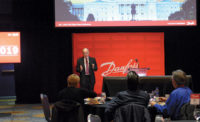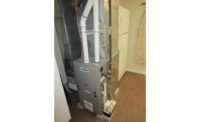Who gets time-and-a-half?
The answer to that question affects millions of workers and business owners, including HVAC contractors and some employees. For the second time in two presidential administrations, the question of who receives overtime pay beyond 40 hours a week is not only up for debate but for official review.
The proposal that the Department of Labor introduced in March to extend overtime eligibility to a class of workers earning up to $679 per week ($35,308 annually) has completed its public comment period. The existing rule exempts similar salaried workers who earn more than $455 per week ($23,660 annually) from receiving overtime.
The Department of Labor estimates that its revision (titled “Defining and Delimiting the Exemptions for Executive, Administrative, Professional, Outside Sales and Computer Employees”) would bring overtime eligibility to more than one million additional workers.
The plan now continues toward development as a final rule.
EARLIER EFFORT STRUCK DOWN
The Trump administration’s effort to widen overtime eligibility follows the Obama administration’s 2016 effort to do the same. However, the current proposal would expand eligibility on a more moderate basis and on terms more favorable to business owners.
The proposed Obama rule had not only set the nonexempt ceiling at a higher $913 per week ($47,476 annually), but it also would have automatically updated the threshold every three years. That rolling update would have been based on the 40th percentile of weekly earnings for full-time salaried workers in the lowest-wage Census region.
The Obama proposal did not alter the “duties test” that is the other component of determining overtime eligibility.
Estimates varied but generally expected over 4 million workers to receive new overtime eligibility in that scenario.
ACCA opposed the 2016 proposal.
“Besides the paperwork and increased costs to run a business, our contractors were concerned for the future of their younger employees,” the association said in a statement. “Contractors would have hired fewer managerial positions, which would have signaled to younger staff that there was little opportunity for growth in their companies.”
Unpopular with assorted business groups, the Obama version received legal challenges and was eventually declared invalid by the U.S. District Court for the Eastern District of Texas before it went into effect.
That ruling stated that the Department of Labor “has exceeded its authority and gone too far with the final rule. The department creates a final rule that makes overtime status depend predominately on a minimum salary level, thereby supplanting an analysis of an employee’s job duties.”
MANUAL, NOT AUTOMATIC
Keith Sonderling, acting director for the Department of Labor’s wage and hour division, spoke on the newest proposal at the Heating Air-conditioning & Refrigeration Distributors International (HARDI) Fly-In, held in Washington, D.C. in May of 2019.
“We used the same methodology as was used in 2004,” Sonderling said, noting that it had received no court challenges and was also already familiar to employers and employees.
In preparation for the rulemaking process, Sonderling said that the department wanted to get as much public input as possible, including a “listening tour” with a series of public forums that included both employee and employer advocates.
Sonderling reported that the department had received over 240,000 comments as of the Fly-In.
The Trump administration’s proposal would commit to assessing the need to open the topic every three years, but it would not include a mechanism for automatically raising the threshold as the Obama-era version had. Likewise, it would not peg the threshold to a percentile of current salary levels as the 2016 plan had proposed. Any actual future revision process would still go through notice-and-comment rulemaking.
While the Obama-era proposal was struck in part for straying too far from the 1938 Fair Labor Standards Act by putting too much emphasis on salaries as opposed to looking at job descriptions, the current proposal also offers no change to the job duties test.
Another key area the Trump administration would leave unchanged deals with groups whose overtime protections would not change under its proposal. The Department of Labor stated that a variety of law enforcement and life safety workers would receive no additional eligibility, along with non-management production-line employees.
But perhaps of most interest to the HVAC industry, that group also includes “non-management employees in maintenance, construction, and similar occupations such as carpenters, electricians, mechanics, plumbers, iron workers, craftsmen, operating engineers, longshoremen, and other construction workers.”
Such a category hints toward a potentially difficult distinction between construction and service/replacement as far as types of contractor work, but official department wording did not specify HVAC-related jobs at all.
WHAT’S ‘PAY,’ ANYWAY?
An ongoing source of contention and uncertainty as the workplace develops is the definition of pay itself — and for that matter, mapping out the edges of the definition of work.
Sonderling said the department has seen a lot of litigation on the matter of determining a worker’s regular rate of pay, a concept which was last updated in the 1950s.
“Employers want a different approach to incentive pay, to bonus pay,” he said.
The department is working on “modernizing to give employers clarity on what needs to be included in an overtime[-determining] rate.”
Sonderling clarified that several forms of secondary compensation in today’s market that employers do not need to count toward a rate of pay include: wellness programs, gym-related expense, employee discounts elsewhere, payments for unused leave or sick leave, some travel reimbursement, assorted benefit plans, and tuition programs.
“You can provide those programs without worrying that it will affect overtime liability,” he said.
He also asked HARDI Fly-In attendees to forward sample programs of these types of benefits offered by their companies.
The Trump administration proposal would include up to 10 percent of bonuses or incentive pay toward the overtime threshold. That percentage mirrors the Obama-era proposal. However, the 2016 wording required such payments to be made at least quarterly to qualify toward the exemption minimum, while the current proposal would not require any such regular intervals.
Under the new proposal, an employer could, for example, make a single year-end bonus payment and retain the ability to consider 10 percent of that as part of an employee’s regular rate of pay.
PHONING IT IN
“This may be kicking a hornets’ nest,” prefaced one HARDI attendee before a question about overtime for hourly employees. He asked for confirmation that if an employee has a personal cell phone and is contacted by work after hours, then that is considered work for the purposes of overtime.
“Technically, under the Fair Labor Standards Act, that does contribute toward 40 hours per week,” answered Sonderling. “[The same answer applies] if they’re reading a work email on the way to work or whatever, even if they aren’t clocked in.”
Sonderling noted that this is another area where opinion letters (see sidebar) could be useful to the department, documenting how such facts and circumstances could apply to member companies. It is also an area where he encouraged employers to craft clear company policies.
Perhaps with an eye toward enforcement and employer options, a HARDI member followed up by asking whether the cellphone scenario would still count toward overtime if there is a specific company policy in place prohibiting using one’s personal phone for work.
“Under the law,” Sonderling said, “it would still qualify as work to be compensated for.”
ACCA-APPROVED
One of the 240,000 public comments came courtesy of ACCA, in the form of an April 8 letter signed by Alyx Simon, government relations representative, and listing the associations advocacy and political action committee (PAC) participants.
“After lengthy review and input from ACCA’s national membership, ACCA will support the proposed rule to increase the overtime rate to $35,308 per year,” Simon wrote. “ACCA members believe the $35,308 threshold is a reasonable increase to rates that have not been updated since 2004. ACCA’s policy leaders believe that the proposal is reasonable and in line with inflation, and any costs associated with this increase could be managed by the businesses responsible for implementing the proposed rule.”
In a separate press release, ACCA president and CEO Barton James described the current effort as “a vast improvement from the previous administration’s proposal.”
TICK-TOCK
Whether they were thinking of adjusting the overtime threshold or updating the terms and wording, the Department of Labor reported that listening tour attendees of all backgrounds had agreed an update was needed in some form.
The current threshold has been in place since 2004, and before that, it had not been updated since 1975. At that point in the 1970s, according to the Obama administration’s White House Domestic Policy Council, the threshold made over 60 percent eligible for overtime. By 2016, overtime eligibility had shrunk to 8 percent of the same category of worker.
According to the Economic Policy Institute’s analysis using the current Department of Labor methodology, the Trump update would raise that number to roughly 15 percent.
From the business management perspective, the nature and numbers of the modern workforce have continued to evolve as well, joined by equipment and technology developments that complicate matters further.
For now, employers and employees alike must wait to see if the Trump proposal draws any legal challenges of its own and whether the considerable public comment leads to any further adjustments as of the next rulemaking announcement.
Get Ahead of That Penalty
The talk spanned more than just overtime rules when Keith Sonderling, acting director for the Department of Labor’s wage and hour division, spoke at the 2019 HARDI Fly-In in Washington this May.
Sonderling emphasized at the start that he and the Department of Labor are committed to making sure that employers have all the information they need to succeed. In an increasingly complex environment, owners may want to take him up on the offer.
Sonderling outlined two specific avenues for working with and steering clear of the department’s regulatory and enforcement wings, respectively.
The department has restarted the practice of issuing opinion letters, Sonderling told the distributor audience. This practice had been suspended in 2009, he said, after a 70-year run.
The opinion letter program allows employers to write and ask a compliance question without disclosing the name of their businesses, and the department will send a response specific to the details of the given employer.
In addition to offering a reliable source of information, Sonderling explained, the opinion letter process can also provide value in hand should a problem arise in the future. Sonderling said that an opinion letter is a legitimate defense against related future claims, demonstrating that an owner not only worked to do the right thing but was following department-issued guidance.
Similarly, Sonderling encouraged business owners to remember the PAY program. In the case of Fair Labor Standards Act violations, resolution is only available through either private litigation or through Department of Labor investigation, he said, neither of which are traditionally very attractive to owners.
However, the PAY program represents a way for employers to come forward in good faith to resolve inadvertent violations. These might include matters related to payroll audits or paying overtime, for example.
“But that’s the key: It has to be proactive,” he emphasized, since the PAY option essentially allows employers to start auditing themselves. Sonderling said that engaging this option can allow owners to protect themselves against the possibility of double damages or liquidated damages that may result without this sort of intermediary step.
Many companies routinely do audits and may find violations, and when that happens, PAY is “a way to conclusively settle those,” he said.
Publication date: 7/8/2019
Want more HVAC industry news and information? Join The NEWS on Facebook, Twitter, and LinkedIn today!








